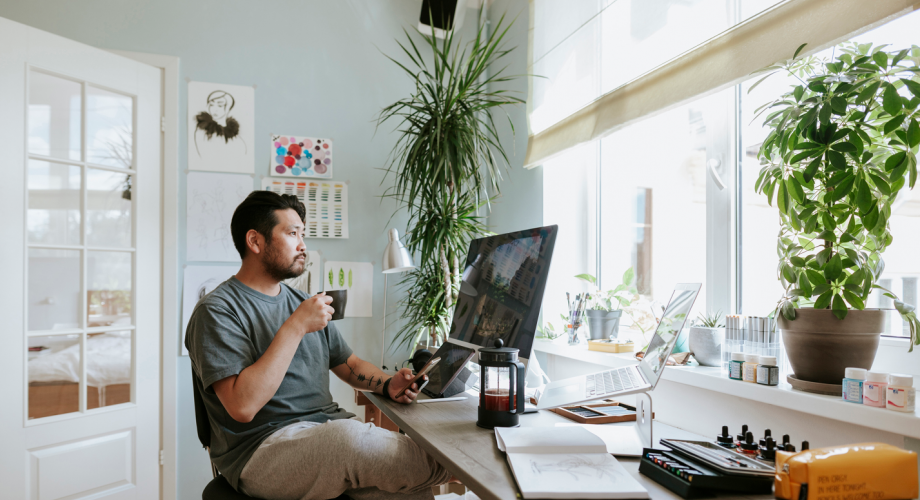Create the right environment for the work-from-home resident that will keep pace with the remote work revolution.
In the not-so-distant past, flashy amenities were a primary way to catch the eye of discerning renters. The more the amenity exuded the ambience of a relaxing, resort-like experience, the better.
While rooftop decks, hotel-inspired swimming pools and posh courtyards still hold value, they no longer serve as tiebreaking factors to renters—at least not as prominently. The work-from-home boom has given residents more of a practical approach when seeking amenities, and co-working spaces, private workstations, reliable Wi-Fi and conference rooms are often more important than a panoramic rooftop view.
Likewise, similar in-home features can be equally important for the modern renter. Anything that enhances remote work, such as built-in nooks for a mini home office, Zoom-worthy communication spaces, noise-reduced homes and prime connectivity all qualify.
The work-from-home trend was already underway before the pandemic, when 20% of employees worked at home most or all of the time, according to data from Pew Research. While the percentage peaked at 71% during the height of the pandemic, nearly half of Americans continue to work from home for at least part of the workweek. According to Owl Labs, remote work has increased 91% over the last decade and 44% in the past five years.
To keep pace, the rental housing industry has to adjust accordingly. Given that so many professionals are residing in rental housing, the remote-work capability at communities has to increase.
Growing Prominence
Residents’ focus on relevant community amenities, lightning-speed internet packages, common areas with connectivity and spaces that foster collaboration—such as WeWork stations and conference rooms—has become even more prominent in 2022. These are investments that most operators weren’t making a few years back and even fewer were incorporating them into the development process.
While many of these items now qualify as must-haves for some renters, a handful of not-so-apparent amenities can greatly improve the experience of a work-from-home resident and make a rental community much more enticing to them. Because the apartment sector also is home to many families—and many of the parents work remotely—children often need something to occupy their time during the workday. Working parents are unable to monitor their children as well as they would during their free-time hours, of course, which has prompted some communities to incorporate designated activity spaces for kids.
Additionally, outdoor working spaces are becoming a key attraction for remote workers at communities in locations where the climate (or season) allows. As such, some properties have modified social gathering areas into more work-centric spaces. These spaces also can serve as a respite for remote workers who might spend the day inside but want to momentarily relax near nature trails, lakes and whatever additional attractions border the community.
While the work-from-home boom has altered the blueprints of rental communities in the predevelopment process, the challenge is different for existing communities. Operators that acquire existing assets are wise to incorporate work-from-home elements into their value-add processes, even if it’s as simple as refreshing apartment interiors to be a little more worker-friendly.
Promoting a New Resident Experience
The rising number of individuals working from home has also increased the sense of community at many properties. Buildings that had been barren during the day are now bustling with a fair sample size of work-from-home residents. As such, it’s highly recommended for onsite teams to dedicate even more focus to the resident experience. This includes the adoption of tech tools that can help operators more efficiently communicate with residents and give them the option to receive notifications on their preferred medium.
Likewise, marketing teams would be savvy to incorporate more information about the community’s work-from-home capabilities into their outreach. With homes now occupied more than ever by remote workers, features such as pool views, proximity to the fitness center or having a home adjacent to the courtyard may become more attractive to residents and could potentially drive premiums.
Outreach efforts can also tout services adopted by the community that can help aid the at-home workday. For example, communities can partner with local pet-walking agencies, offer onsite dry cleaning, provide housekeeping services or anything else that can aid a busy remote worker. This can even include improved fitness centers now that many residents will be more conscious of their health while largely remaining at home.
Onsite teams previously focused almost exclusively on leasing because many residents were offsite during the weekday hours, but the focus has changed. They now must adjust and dedicate a significant portion of the workday toward enhancing the resident experience. That objective can begin early in the operations process, as some operators are now training leasing agents to be even more engaging and customer-centric. Those professionalism-boosting training efforts can expand to the maintenance team, as these associates now more frequently interact with residents during the workweek. Creating a healthy morale among increasingly at-home residents is something that can permeate through the building and aid in resident-retention efforts.
Although the propensity to work from home has cooled since the height of the pandemic, the trend is here to stay in the apartment world. Companies across the globe are continuing to offer remote work as a perk to attract and retain employees, as the percentage of U.S. companies that disallow remote work of any kind has dropped to a mere 44%, according to the Owl Labs study.
Operators that embrace the boom, incorporate work-from-home spaces, add relevant services to aid remote workers—and are very intentional in their marketing efforts to highlight these qualities—are one step ahead of the curve. And thankfully, unlike other temporary trends in the past, they don’t have to worry about this one being a passing fad.
Sergio Chidichimo is Senior Vice President of Operations for Birchstone Residential. He is a member of the Apartment Association of Greater Dallas’ 2022-2023 Board of Directors.
